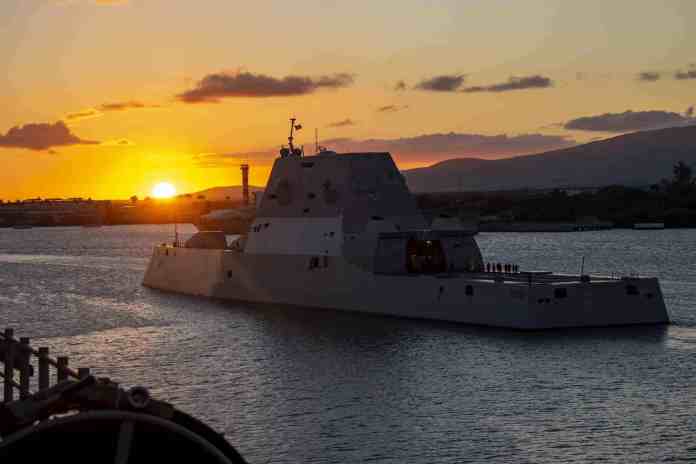
USS Zumwalt (DDG-1000) was once described as the future face of naval warfare – a next-generation high-tech destroyer with its sleek, stealthy design and not one but two 155mm Advanced Gun Systems (AGS) capable of launching shells deep into the target area. The Navy’s starting point was somewhat exaggerated: 32 ships of the Zumwalt-class, where each one would have been the most powerful in the world. However, the sky-high dream was gone with the second-hand wind. Expenses going up, problems becoming technical, and changing plans led to the production of only three ships. There still is a $22 billion monument of daring innovation and the catastrophe of overextending. One modern combat Desert Storm was a record-breaker even before the war started.

Zumwalt’s initial showpiece was the AGS, which could launch GPS-guided Long Range Land Attack Projectiles (LRLAP). The projectiles could dive onto targets with near-vertical accuracy. The rub? Every shot would have had a mind-boggling price of approximately $800,000, much too expensive for prolonged use.

With changing naval priorities away from the closer-shore bombardment and into the open ocean competition, the AGS soon lost its utility. Ideas such as railguns, planned originally for Zumwalt’s enormous power supply, were also abandoned, with much of the destroyer’s potential left unexplored.

The break came with the decision to equip Zumwalt with hypersonic missiles. To accomplish this, the Navy refurbished the vessel at Ingalls Shipbuilding in Mississippi, taking her out of the water for a year of upgrades. The heavy AGS turrets were expunged—one replaced with launch canisters for the new Conventional Prompt Strike (CPS) missile, and the other left open for future configurations.

Now, Zumwalt is capable of carrying twelve CPS missiles, each a boost-glide weapon with the ability to hit targets at ranges of up to 1,725 miles with velocities of over Mach 5.

This change was not just a weapons upgrade—it was a shift in mindset. Hypersonic missiles can race toward their destinations so rapidly that defense systems have trouble responding, whether the target is a ship, command post, or key infrastructure. CPS tests have already been successful, and future refinements can potentially enable such missiles to change course during flight or even pursue moving targets. In an age where speed and accuracy are the measure of survival, Zumwalt suddenly found her niche.

But the ship is about more than firepower. Her Integrated Power System (IPS), fueled by two Rolls-Royce MT30 gas turbines, produces 78 megawatts of electricity. Even operating at 20 knots, the destroyer has power to spare—enough to power 10,000 houses. That excess makes her an obvious proving ground for future directed-energy weapons and next-generation sensors. Her wave-piercing tumblehome hull and composite deckhouse make her harder to see, although subsequent modifications have minimized her stealth profile.

Despite being challenged regarding her design, Zumwalt still holds formidable power. She is equipped with 80 PVLS or Peripheral Vertical Launch System cells for Tomahawk, Standard Missile, Evolved Sea Sparrow Missile, and anti-submarine rockets. The 147-strong, elegant complement of the Navy, with accommodation for 28 Marines, is a clear indication of the Navy’s move towards the efficient use of resources and reduced manpower requirements. Apart from that, her SPY-3 radar enables easy tracking of threats from the air or surface in enemy territories.

The hypersonic upgrade adds actual heft to her mission. The CPS also has the same Common Glide Body design as the Army’s Long Range Hypersonic Weapon, making it easier and less expensive to produce. Navy leaders can’t wait to fully integrate it into its fleet, recognizing that having such an ability at sea has the potential to revolutionize fleet operations in the coming years.

It’s a narrative of ambition and restraint in many senses. Risks are involved in taking pioneering new technologies—overruns, canceled projects, and shifting missions—but the ship’s power systems, stealth design, and now hypersonic strike capability are enormous accomplishments. What’s been learned is already influencing the next generation of DDG(X) destroyers, which are set to combine the innovations of Zumwalt with the reliability of established Arleigh Burke designs.

As the Navy strides into the future, Zumwalt’s destiny remains to be written. Will she be the hypersonic giant in waiting, or a multi-billion-dollar experiment? Today, she remains evidence of what occurs when bold concepts are pushed at sea—a warship conceived in innovation, reshaped by pragmatism, and still at the vanguard of naval combat.